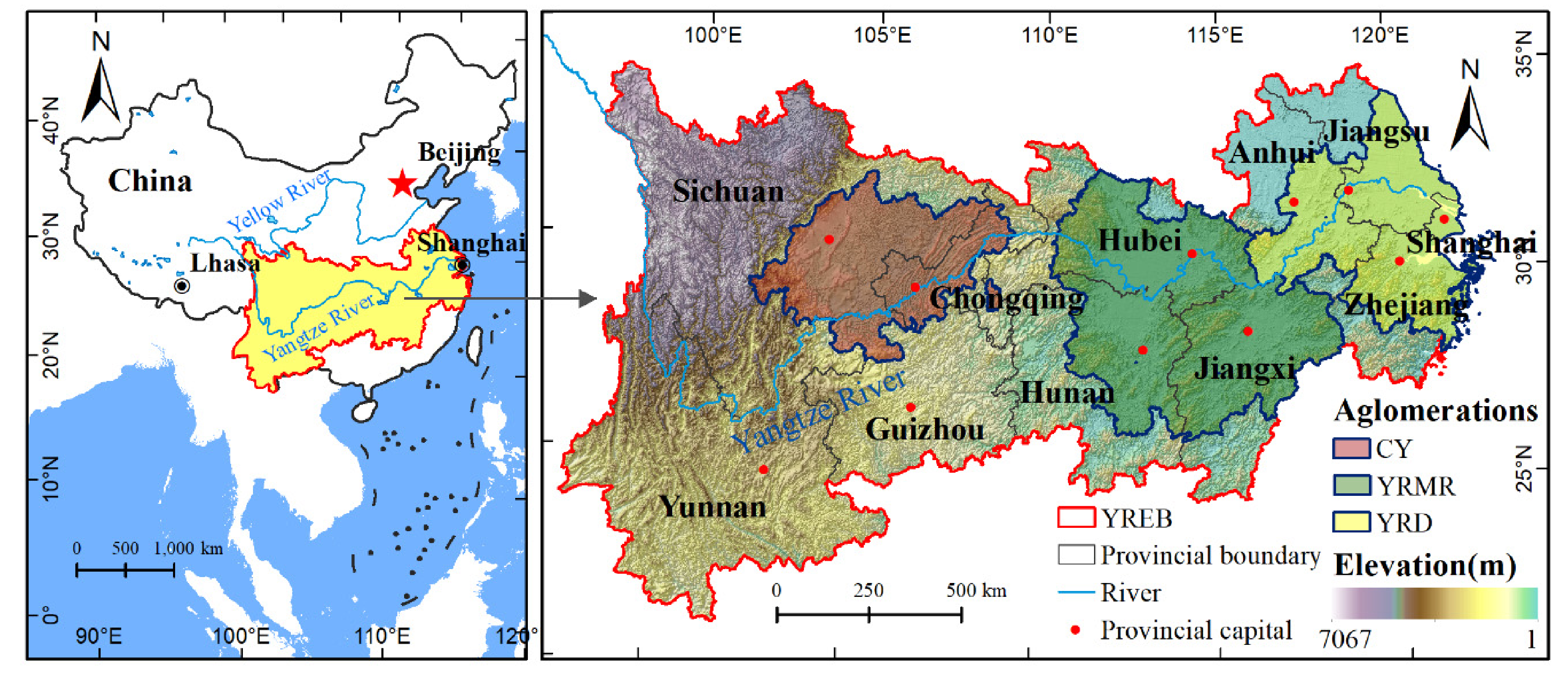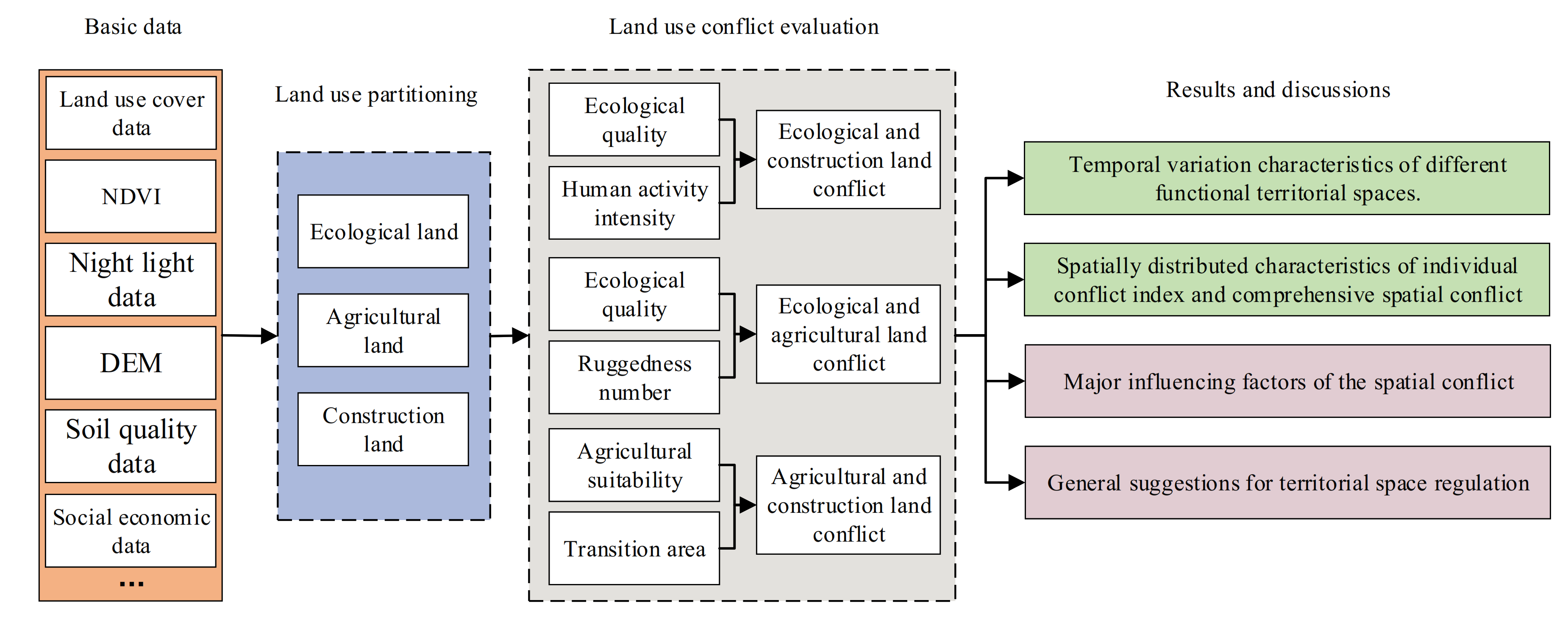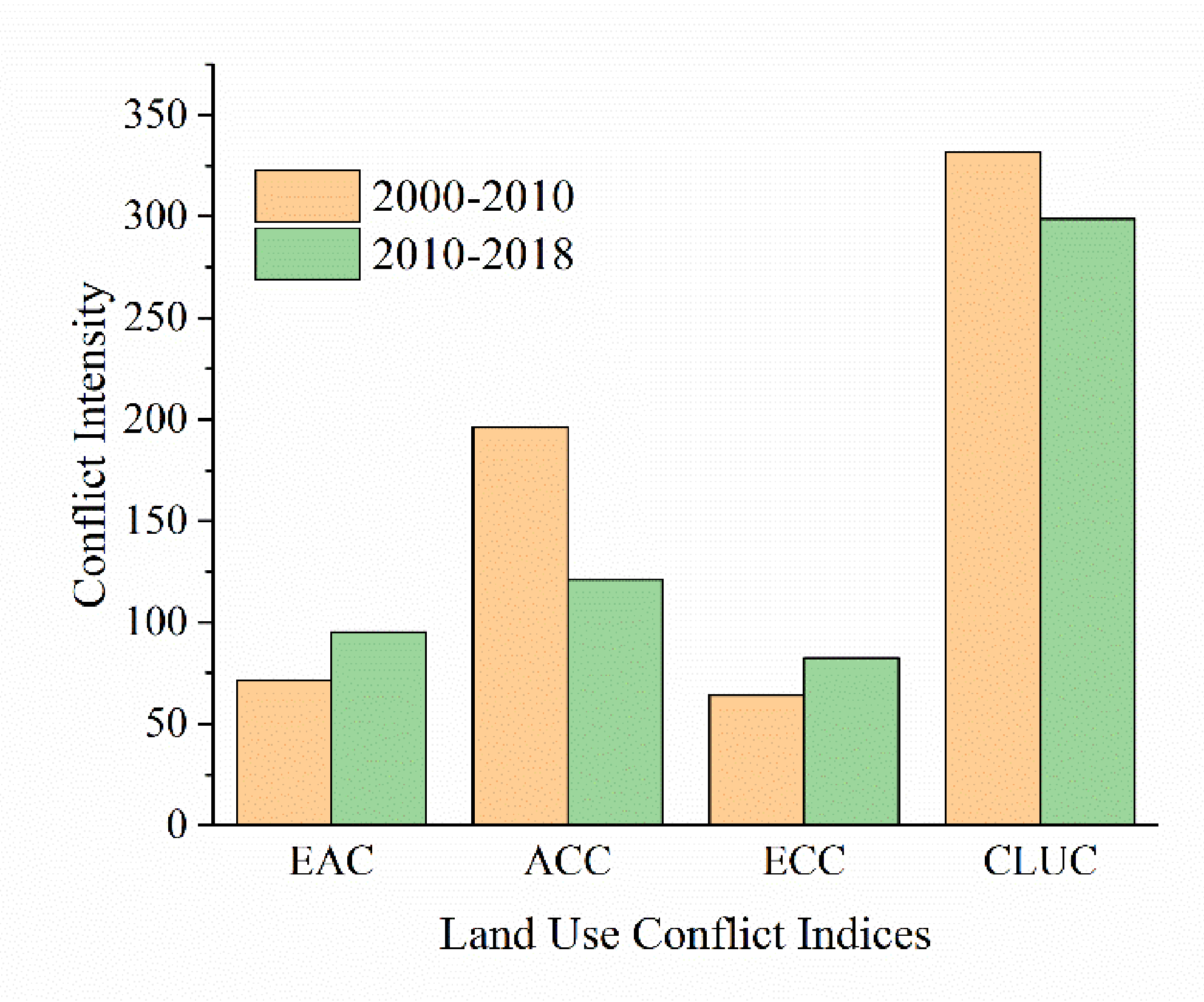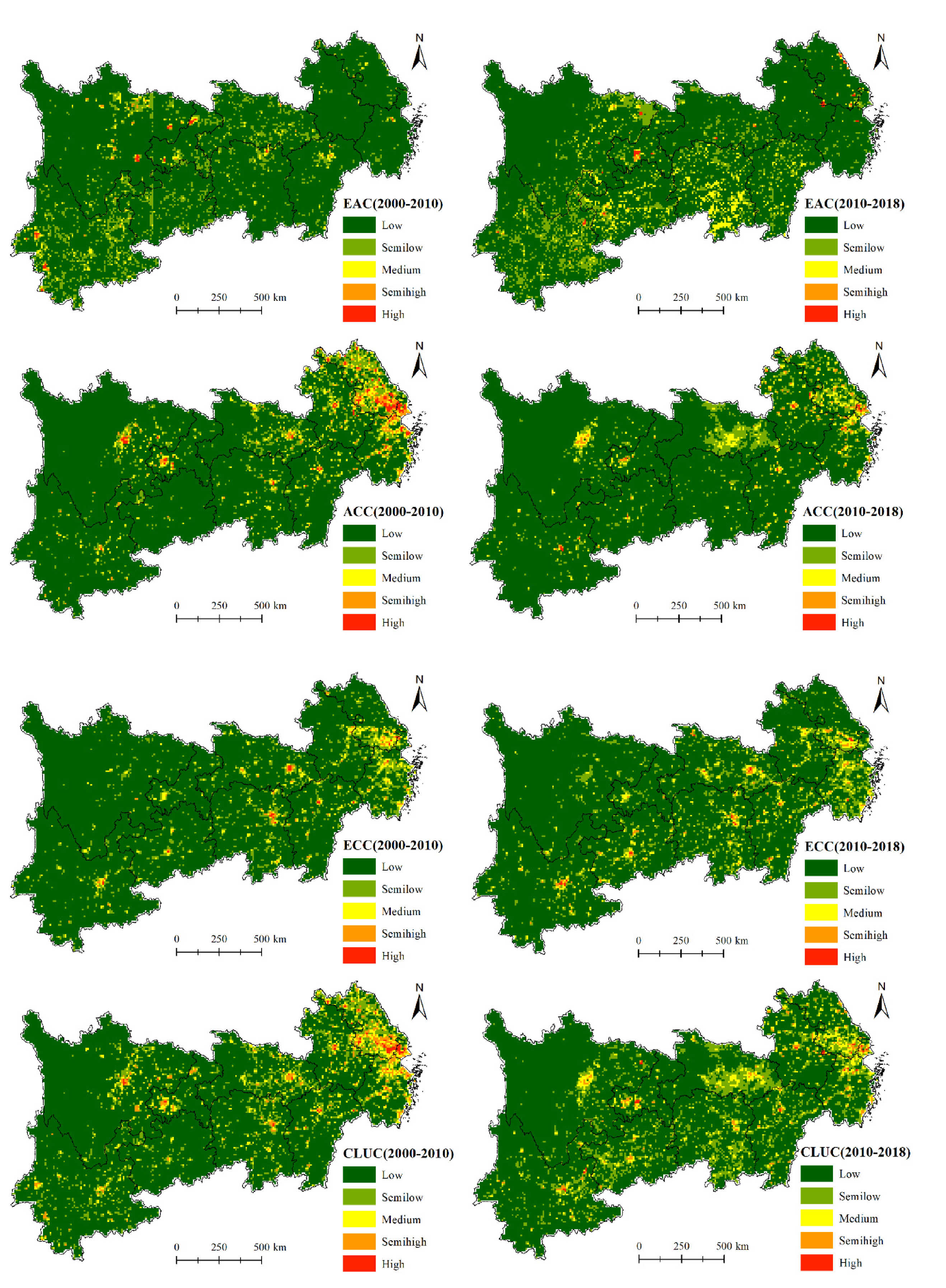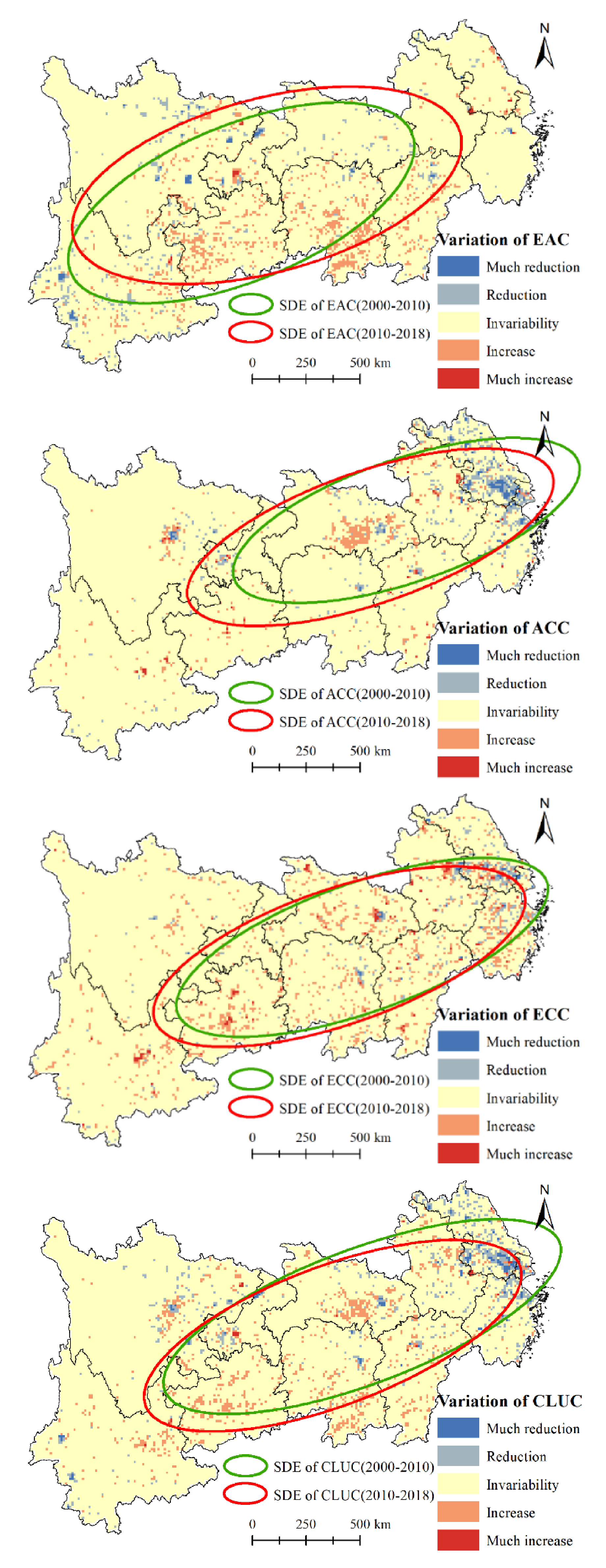1. Introduction
Along with increasingly extensive and intensive human activities, the exceptional pace, magnitude, and spatial reach of human alterations of Earth’s surface since the industrial revolution, or even earlier, has taken us to a new geological era called the Anthropocene [
1]. Given that humans have increasingly become the predominant environmental force apart from geophysical sciences, the concept of the Anthropocene has been enthusiastically received [
2,
3]. The controversial idea of the “Age of Humans” has been extensively investigated by scholars from numerous other disciplines and public media and promoted the consideration of the human–nature relation [
4]. Land use and land cover change (LUCC) is an important research topic that tackles the changing human–nature relation and a core project of IGBP (International Geosphere Biosphere Programme)and crossover research of IHDP (International Human Dimensions Programme on Global Environmental Change) [
4]. The competition among different land use types over limited land use resources with remarkable urbanization and economic development, such as expansion of mankind landscape at the expense of ecological space, has been a primary feature of LUCC [
5,
6]. LUCC and the trade-off between different land use types has formed serious land use conflicts represented by environmental damage, including habitat loss, biotic diversity decline, climate change, and soil degradation [
4,
7,
8], as well as social problems, such as the vulnerability of places and people to climatic and economic or sociopolitical perturbations [
9,
10,
11,
12]. In addition, many land use transitions have taken place over wild areas both from the dominant morphology and recessive morphology with the quantity, spatial structure, and function change of land use and land cover [
13,
14,
15]. On the one hand, land use transitions are largely driven by different land use types representing the benefits of different departments conflicting in space and will lead to a new balance of regional land use morphology patterns [
16,
17].On the other hand, land use transitions may trigger new land use conflicts during transformations between different land use types and allocation of land resources due to policy and institutional failures [
14,
18]. Thus, exploring the spatiotemporal characteristics of land use conflicts is an important research topic to enhance the understanding of the human–nature relation and provide critical insights into the dynamics of land use transitions.
Land use conflicts occur whenever land use stakeholders have incompatible interests about how land is used in local areas [
19]. Land disputes are the manifestation of land use conflicts when incompatible interests related to certain land units occur between specific stakeholders, such as developers, farmers, and local residents. For example, the controversial land compensation through large land investments and land acquisitions that led to a large number of land disputes between residents and developers, can pose a risk to social stability [
20]. Another manifestation of land use conflict is the presence of the environmental land use conflict between land users and the public interest in ecological protection that typically occurs during the competition and compromise between different objectives for all land uses within a limited space [
19,
21]. Human land use (agriculture, exploitation of mineral resources, industrial production, and living activities) commonly have negative ecological and environmental impacts, such as consumption of highly productive agricultural land, occupation of rural residential communities, and destruction of ecological spaces that lead to growing conflicts between economic gains, social objectives (food security), and environmental goals (biodiversity conservation, ecosystem services provision, habitat integrity, and biodiversity) [
22]. In addition, the implementation of some environmental protection policies can conflict with native residents, such as pastoral evictions due to the implementation of green economy in Tanzania [
23]. Rapid urbanization and economic development cause extensive environmental land use conflicts. This complicated problem has attracted considerable research attention. Some scholars have carried out in-depth investigations on the ecological environmental impacts of land use conflicts [
24,
25]. Other scholars have focused on the potential land use conflict over current and proposed uses [
26,
27]. Another issue that has drawn considerable research attention is conflict resolution, and varied approaches have been proposed to solve this complicated problem [
28,
29,
30]. However, comprehensive investigations on the spatiotemporal characteristics of land use conflict from the perspective of ecology based on a spatially explicit evaluation approach around a large-scale range are lacking, and studies on the driving factors of environmental conflicts are inadequate.
Land use conflicts are complex processes and various aspects must be considered. Several valuable approaches on land use conflict evaluation from an ecological perspective have been developed. Some scholars evaluate land use conflict through the degree of deviation between the actual land use from the most adequate land use standing on a capability evaluation (called natural use), while the ruggedness number is widely used to evaluate land capability [
24,
25]. The evaluation approach, based on the ruggedness number, is suitable for identifying the land use conflict in rural areas filled with farmlands and forest spots but unsuitable for rapidly urbanized areas. Some scholars proposed a linear conceptual model considering the complexity, vulnerability, and stability of land use units, while some scholars proposed another linear conceptual model considering spatial type, spatial structure, and spatial process conflict indices, to calculate the land use conflict in urbanized areas [
21,
31]. In addition, the comprehensive assessment from three aspects, including conflicts over land use structure, land conversion, and landscape pattern, were proposed to calculate the land use conflict [
19]. These two evaluation approaches can properly evaluate the status of land use conflict but fail to examine the land use conflict occurring among land use transitions within a period. Furthermore, multicriteria analysis and multisuitability evaluation of construction, agricultural, and ecological lands were used to calculate potential land use conflict [
32,
33]. However, to date, analyses that directly examine the actual occurrence of land use conflict during land use transition processes are limited. A spatially explicit land use conflict evaluation approach that simultaneously considers the transition among ecological, agricultural, and construction lands triggered by human activities in rapidly urbanized areas is proposed in this study.
China has experienced rapid urbanization and economic development in the last 40 years since its opening and reform [
34]. Acceleration of industrialization and urbanization as well as population and industrial agglomeration has intensified land development and utilization intensity [
35]. Large-scale land development and utilization has led to alterations of local ecological landscapes and increasing food demand of the growing population driven by agricultural land reclamation. Chaotic land use patterns due to planning control failures and inefficient land utilization cause land use conflict in many regions across China [
36,
37]. Territorial space suffers from wastage and unreasonable use of land resources as well as environmental and ecological degradation [
38,
39]. Optimization of territorial space development has recently attracted considerable research attention under ecological civilization construction. Coordination and optimization of territorial space, which are crucial in effective territorial space development, have become important research topics [
40]. However, scientific understanding of the spatiotemporal dynamic pattern and driving factors of land use conflicts is still limited, especially on a large regional scale [
41]. The Yangtze River Economic Belt (YREB), a rapid economic development region in China with accelerated industrialization and urbanization, causes serious urban expansion and land use change [
42]. Economic development, economic activities, infrastructure, and residences have clearly extended the scope and depth of urban areas to their surrounding virgin territories [
43,
44]. Natural land covers have been increasingly converted into urban impervious surfaces, with urban expansion exhibiting very fragmented characteristics [
45,
46]. The complexity of this phenomenon and its effects influence many ecological and environmental impacts, such as increased soil erosion [
47], poor water quality [
48], and reduced aquatic biodiversity [
49], from local to global scales. The scarcity of land resource has led to the accumulation of land use conflicts over time. The spatial conflict of land use in small regions has been explored in many studies while investigations on spatial conflict in large regions and its driving forces are relatively rare [
50,
51]. Research on spatiotemporal patterns and land use conflict of the territorial space in YREB can help identify policies and practices to mitigate conflicts. This work examines issues that planners, land use managers, and practitioners must address when dealing with the complexity of land use change in the area.
This study primarily aims to (1) explore the spatiotemporal characteristics of land use conflict in YREB between 2000 and 2018, (2) develop a step-wise multiple linear regression model for identifying socioeconomic driving forces of spatial conflicts, and (3) propose some policy implications of the spatial control of territorial space within the study area while estimating land use conflict. Our study will provide a spatially explicit evaluation framework and contribute to the understanding of underlying driving forces of land use conflict.
6. Conclusions
Land use conflict is an important problem in land use transitions and territorial space development. This article proposed a new framework to evaluate the land use conflict spatially and explicitly from the three aspects of EAC, ACC, and ECC. This article then examined dynamic changes of land use conflict and performed Pearson correlation versus step-wise linear regression to determine factors that influence land use conflict during 2000–2018 in YREB, which is an important economic belt in China. The period of 2010–2018 demonstrated slightly lower compressive land use conflict than the period of 2000–2010. However, considerable differences exist in various conflict types. ACC reduced remarkably by 38.26%, while EAC and ECC showed a slowly increasing trend. The spatiotemporal dynamic pattern of each conflict indicator exhibits unique features. Higher and high values of the EAC were relatively decentralized and mainly spread out over middle and western inland regions. The period of 2010–2018 demonstrated higher intensity of EAC, with its center shifting to the east, compared with the period of 2000–2010. Areas with higher and high values of ACC are concentrated around three urban agglomerations, with YRD exhibiting the highest intensity. Compared with the period of 2000–2010, ACC evidently reduced and shifted to the west during 2010–2018. The ECC trend was evidently high in the east and low in the west. Compared with the period of 2000–2010, the overall ECC trend increased both in size and distribution and transferred to the west during 2010–2018. CLUC was mainly concentrated in central cities in middle and western inland regions and widespread in YRD. The overall CLUC transferred from east to west. Variables from three aspects of demographic, economic, and life factors significantly affected land use conflict. Policies, such as improvement of the territorial space planning system and promotion of comprehensive land adjustment, were put forward to adjust land use conflict.
This work has the following limitations. The land use conflict only considers transitions of land use categories but ignores the landscape change of the region. In addition, the driving factor analysis includes incompetence socioeconomic factors due to the data limitation. The exploration of the spatiotemporal dynamic pattern of land use conflict is a significant piece of work which can enhance the understanding of the dynamics of land use transitions and reveal the problems of agricultural land shrinking and environmental and ecological degradation during rapid urbanization and industrialization. Therefore, it is important to constantly monitor the land use conflict to identify the state of regional territorial space development and constantly adjust governance measures. The evaluation approach of land use conflict needs further improvement to provide deeper insight and more details of the analysis results. Future studies can focus on improving the analysis framework of land use conflict and further explore additional driving factors.
